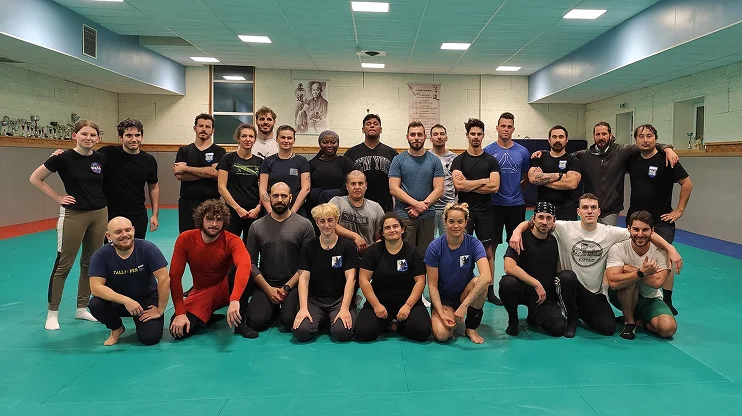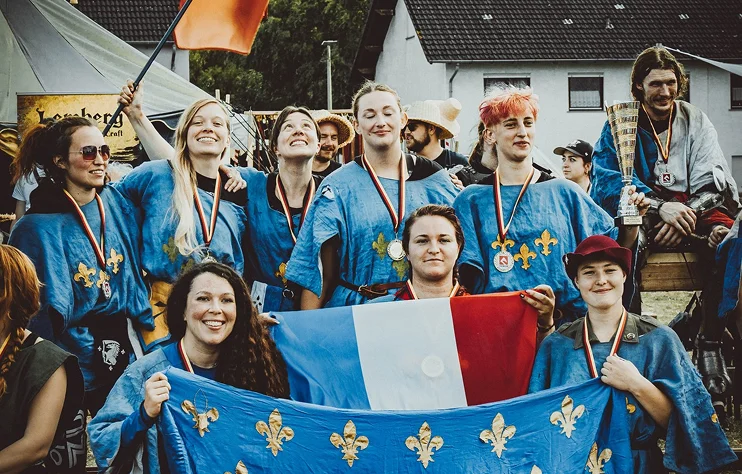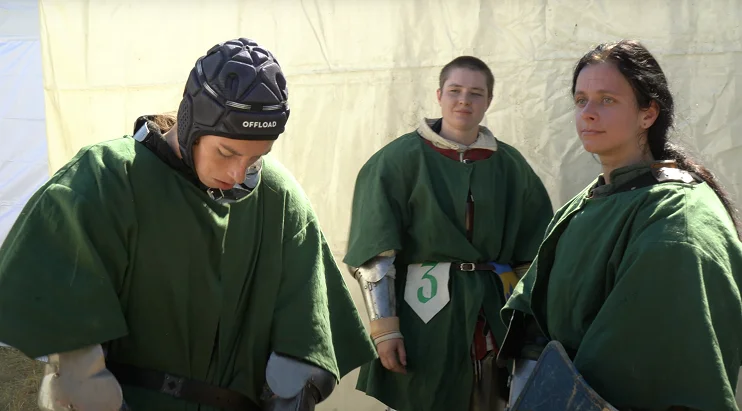Introduction — A Rising Force in the List
Buhurt, the medieval full-contact armored combat sport, is as brutal as it is strategic. Long perceived as a man’s world, the sport is now being shaken up by a new wave: women stepping into the list with determination, power, and passion.
Through the voices of Jessie Lopez, a young and bold fighter, and Louise Hullin, captain of the French national women’s team, we uncover a world made of sweat, steel, perseverance, and sisterhood. Two different paths, but the same goal: to push female Buhurt forward in France and beyond.
Fighting Spirit: From Nerves to Joy
“I just want to have fun!” laughs Jessie Lopez when asked how she feels before entering the list.
At 25, Jessie has been training in Grenoble for almost two years with the Sangliers d’Isar and fights with the women’s team Griffonnes d’Auvergne. Like many, she admits to feeling nervous before every tournament:
"Honestly, I feel like I’m gonna pee myself! And since we don’t train that often as a women’s group, I always get a bit anxious."
But everything changes the moment she steps into her armor:
“As soon as my foot goes into the armor, there’s nothing. Just emptiness. And once I’m in the list, it’s pure pleasure.”
Louise Hulin, 31, captain of Les Lys de France, shares the same experience — despite five years of high-level competition:
“You always get the jitters. The heart starts racing. It’s just competition stress — it means the adrenaline’s kicking in.”
For Louise, the key during combat is to stay focused and calm:
“I force myself to stay relaxed in the middle of chaos. It sounds easy from the outside, but on the inside, it’s a real mental effort.”
Preparation, Discipline, and Grit
Behind the strikes and steel, Buhurt is built on discipline. To survive and thrive in the list, you need to build both your body and your mind.
Louise is incredibly structured in her training:
“Before a competition, I train 5 to 6 times a week. I focus on strength training, rugby-style conditioning — mobility, agility, and power.”
But she emphasizes that gym training alone isn’t enough:
“If you’re not also doing Buhurt, you’re wasting your time. Early in the year, I build my body. Closer to the tournaments, I go all-in on Buhurt.”
Jessie, more instinctive, focuses on her personal weak points:
“I do quite a bit of strength training, with a focus on striking techniques — that’s still where I feel I’m not strong enough. I’m working on generating more power, more intensity, really getting into it and hitting with impact. I try to train a little every day when I can.”
Mentally, they have very different approaches.
Jessie’s go-to is music:
“I usually blast metal right before arriving — it gets me in the zone, fully pumped. And I know I’m not the only one who does that!”
Louise, meanwhile, practices visualization:
“I watch hours of footage. French fights, international fights… I analyze everything. I imagine myself in the list. I create muscle memory for the movements I want to perform.”
That preparation pays off when fights come one after another in competition:
“You don’t build endurance the night before. If you’ve trained hard, the tournament feels easy. Hard training, easy war.”
What It Takes to Fight — And Keep Going
Buhurt is not for the faint of heart. It demands toughness, passion, and resilience — both physically and mentally.
For Jessie, it all starts with knowing why you’re here:
“You need to be passionate. You can’t be afraid of taking hits — some people still hesitate with that. And you’ve got to have discipline. With those three things, you’re already off to a strong start.”
Louise adds another layer: self-awareness.
“The #1 quality of a good fighter is knowing where you’re at. Be honest about what you’re good at and what you’re not. I don’t take risks on things I know I can’t handle. I play to my strengths.”
And that honesty continues after every fight:
“Watch your matches. Don’t be afraid to criticize yourself — but also celebrate your wins. That’s how you progress.”
So how do you start?
Both say: don’t do it alone.
“Find a club near you and ask for advice,” says Louise. “Don’t show up like a tourist. Talk, train, and above all — don’t buy gear before talking to a club. It has to be specific and safe.”
And be prepared for the sport’s unique demands:
“Even if you run marathons, it doesn’t mean you’ll instantly do well in buhurt. It’s a sport with its own specific demands — physical, mental, martial... it’s a full package. But don’t let that scare you off. You don’t need to be a machine to start — you just need the drive to learn, and a bit of patience with yourself. Go for it, but give yourself the time to grow into it.”
Jessie sums it up in her own way:
“Just go for it. Don’t overthink it. Try it, take a few hits, love it, keep going — and boom, you’re in.”
Strength in Numbers: Clubs, Teammates, and the Crowd
In a sport this intense, your support system makes all the difference.
For Louise, the men in her club in Angoulême have played a crucial role:
“They’ve been training with us for five years. Encouraging us, believing in us. That’s why we perform today — because we’ve got a family behind us.”
She’s clear: not all clubs used to support women, but things are changing:
“More and more guys are learning to work with women in this combat sport. It takes awareness, and we’re super thankful for the ones making that effort.”
And what about the crowd?
Both fighters agree: yes, it has a real impact on performance.
“It’s tough walking into the list and seeing the crowd walk away,” Louise says. “Even if you’re focused, the vibe around you affects your energy.”
When people are watching, screaming, hyped — you feel it, even under layers of steel.
Jessie adds her own twist:
“Before fighting, I scream. Sometimes I dance. It makes people laugh — it lightens the mood.”

A Golden Moment: Way of Honor
Some victories are more than medals — they’re a symbol of survival and growth. For Louise and the Lys de France, the Way of Honor tournament in Germany was exactly that.
“It was probably the biggest women’s tournament of the past ten years,” Louise recalls. “Ten top-tier international teams — British, Finnish, American… The level was insane.”
France not only showed up — they dominated, winning two gold medals: in 5v5 and 12v12.
“It was the result of years of work. After COVID, women’s Buhurt in France almost died. No fighters, no momentum… But we didn’t just survive — we came back stronger.”
That moment on the podium was more than a win. It was a reward for years of perseverance:
"All those years of not giving up — they were worth it."
A source of pride for the whole team... and a strong message to the European scene: French fighters are here to stay.

Changing the way we look at women's Behourd
One of the biggest challenges for women in buhurt? Being taken seriously — not just as fighters, but as athletes.
“People still see buhurt as a medieval show,” says Louise. “But it’s a real sport. Just like any combat discipline — it has rules, rounds, refs, and strategy.”
She believes it’s crucial to help the audience understand what they’re watching:
“When a speaker explains what’s happening, people get it. They follow the strategy, see one team setting up, the other countering… It becomes a game. Not just a show.”
This need for recognition is even greater when you're a woman in this business. Because you constantly have to prove that you're legitimate. That this is not re-enactment or folklore, but high-level sport.
And this view is changing, little by little, thanks to performances like those of the Lys de France, thanks to the work of the clubs, and also thanks to the words of female fighters who are taking their place in the public arena and the media.
What about tomorrow? The future of women in Buhurt
For Jessie and Louise, the future of buhurt is not just promising — it’s already happening.
“Every year there’s more people, more public, more fighters,” Louise says. “Especially women. A few years ago, we could count ourselves on one hand. Now we’ve got full teams.
We even managed to field four 3-woman teams and a full 5v5!” she adds. “And the level keeps rising — for women and men alike.”
Jessie, looking ahead, keeps it simple:
“First, I want my own armor — not borrowing one all year! But beyond that, more fights, more girls… and maybe someday, a full women’s tournament.”
Women in buhurt are no longer a rarity — they’re a movement. With fighters like Jessie and Louise leading the way, backed by solid clubs and growing public support, the sport is changing.
They’re not guests in the list. They belong there.
And their story is just getting started.

